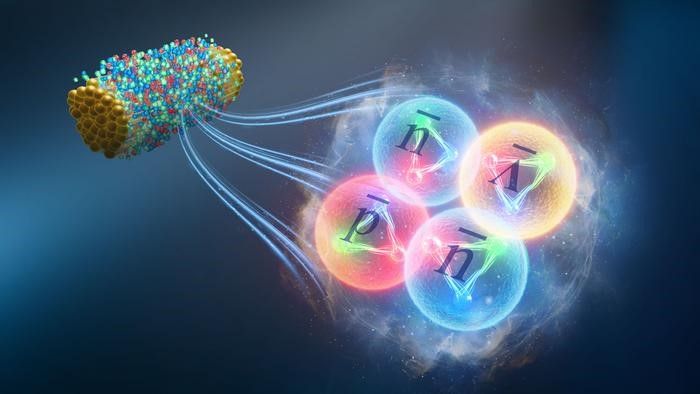Heaviest antimatter particle ever discovered could hold secrets to our universe's origins
By Ben Turner
published August 21, 2024
The newly found antiparticle, called antihyperhydrogen-4, could have a potential imbalance with its matter counterpart that may help scientists understand how our universe came to be.

An artist's illustration of an antihyperhydrogen-4 antimatter nucleus being created from the collision of two gold nuclei. (Image credit: Institute of Modern Physics, China)
Scientists have spotted the heaviest antimatter nucleus ever detected lurking in a particle accelerator.
The antimatter heavyweight, called antihyperhydrogen-4, is made up of an antiproton, two antineutrons and one antihyperon (a baryon that contains a strange quark). Physicists found traces of this antimatter among particle tracks from 6 billion collisions at the Relativistic Heavy Ion Collider (RHIC) at Brookhaven National Laboratory in New York.
By studying the strange particle, physicists hope to discover some key differences between matter and antimatter, which may help explain why our universe is now filled with matter given that antimatter was created in equal amounts at the beginning of time. The researchers published their findings Aug. 21 in the journal Nature.
"Our physics knowledge about matter and antimatter is that, except for having opposite electric charges, antimatter has the same properties as matter — same mass, same lifetime before decaying, and same interactions," study co-author Junlin Wu, a graduate student at the Joint Department for Nuclear Physics, Lanzhou University and Institute of Modern Physics, China said in a statement. "Why our universe is dominated by matter is still a question, and we don't know the full answer."
More:
https://www.livescience.com/physics-mathematics/particle-physics/scientists-discover-the-heaviest-antimatter-particle-ever-and-it-could-hold-secrets-to-our-universes-origins
